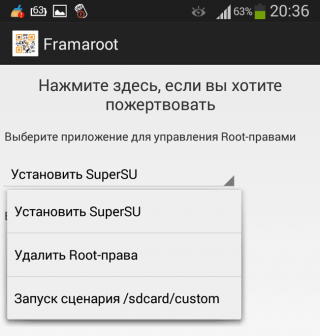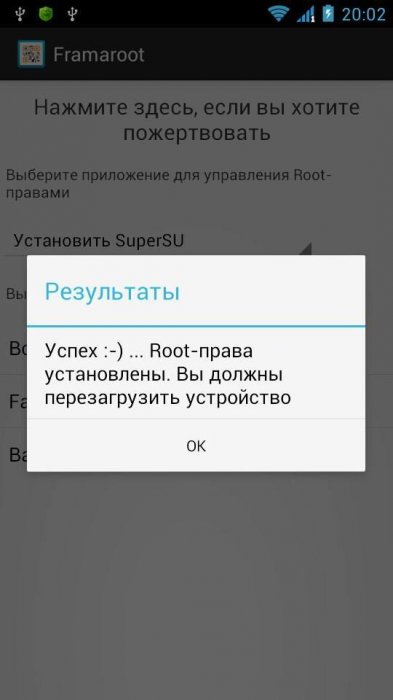Why is root not installed? No root required! Why you shouldn't install Root on new Androids
By getting root rights to your Android device, you can get a lot of benefits, significantly expanding the capabilities of the gadget. But the concept of root implies several negative aspects that will be discussed in this publication. If you are still undecided whether you want to get superuser rights, then this article will help you find answers to all your questions and dispel doubts.
Security issues
Naturally, having received root rights and you will significantly expand the functionality of the device. Among the pleasant nuances are special applications that are not available for standard firmware. These elements software will open up new perspectives for the user, but can also harm the device. By prohibiting applications from using root rights, you can protect your device from negative influence, since installed utilities request access. Before installing the application, it is recommended that you familiarize yourself with its purpose, capabilities and additional powers that can be easily limited.
Manufacturer's warranty
You must know that once you receive superuser rights, you will completely remove the factory warranty from your smartphone or tablet. True, in theory, the warranty can be restored back by installing standard firmware, but, unfortunately, this trick will most likely not work. Some Android devices save information regarding the firmware used. A smart specialist can easily check the phone’s database and find out the cause of the breakdown. Of course, not everyone is so responsible, and if the device breaks down, your trick of restoring the factory firmware may work.
No single installation method
Get root rights for android devices from different manufacturers impossible using the same method. For use the Odin program, for Nexus flagships the command line on personal computer. So, there are some inconveniences during the installation process.
Updates
After receiving superuser rights, you will have to perform the update yourself operating system devices. No longer automatic updates. This fact is another disadvantage and a price to pay for universal capabilities.
conclusions
It’s worth thinking about whether root rights are needed at all? Remember to think about this question, because the process getting root rights to android is not entirely justified. An exception may be your desire to rape your smartphone, having tried a huge amount of software, which already implies installing superuser rights.
Framarut – Android application, manager root applications. With one click you can set superuser and SU mode on your phone. Before downloading Framaroot for Android, check out the list compatible devices to see if this root manager can be installed on your phone.
Very important information
Obtaining root rights voids the warranty on the Android device. So always think about whether you need such risks.
If you need help, read about Framaroot below.
Installing Framaroot on Android in 3 steps
1. Download the Framarut application to your Android device. You can download the distribution for free on the forum http://forum.xda-developers.com/ or the 4pda.ru forum.
2. Install the apk application framaroot.apk from underneath or directly in your Internet browser window.
3. If Android warns you about the risk of a potential threat in Android, click OK and enable the "Unknown sources" option in the "Security" section to install the Framaroot program outside Google Play Store.
Framarut installation, obstacle avoidance
 Installing Framaroot 1.9.3 from a file manager
Installing Framaroot 1.9.3 from a file manager
Using the Framaroot application to obtain root rights
Open Framaroot 1.9.1 ( latest version) and choose one of the following:
- Install SuperSU
- Execute root devices
- Run script (for advanced Android users)
 Options when working with Framaroot 1.9.3 on Android
Options when working with Framaroot 1.9.3 on Android Possible behavior when running Framaroot on your mobile device
- A pop-up message Your device seems not vulnerable to exploit included in Framaroot will appear - in this case you can remove the application - it will not help with your configuration.
- You will see one or more firmware methods. Click on one of the buttons after you have selected an action, one of the above messages will appear:
- Success(Superuser and SU binary installed). You must reboot your device
- Failed(Operation failed) ... The exploit works, but installing root rights on Android as a privileged user and SU is impossible
- Half-Success:-/ (Almost there)... The system partition is read-only, use the local.prop trick. Reboot your device.
- Failed... Try another exploit if available
- Framaroot frozen or closed, in this case you should run Framaroot a second time and select the same action and try to root your smartphone or tablet again.
 Error getting root rights
Error getting root rights Questions and answers on using Framaroot
Will FramaRoot application manager version 1.9.1 work? on my device?
If android device is in the compatibility list, short answer: yes, but it depends on your version Android firmware. U latest firmware, alas, there is less chance of getting root rights (until someone invents a solution).
If your device is NOT on the compatibility list, but the processor of the Android device is mentioned in the list above, the answer is: try it and see for yourself.
Why doesn't framaroot root my Android anymore after I updated my device?
Since the root application manager framaroot exploits security holes that exist in several devices, they have been fixed with the update, so Framaroot cannot be successfully rooted. Framaroot patches have a very short lifespan to keep your device "less susceptible" to other malicious applications. Please also keep in mind that framaroot is not a root application in the full sense of the word. This utility exploits Android OS vulnerabilities to gain enhanced privileges.
I lost root access after updating, what can I do to get my Android device back to root?
Tip: if you want to keep the root after updating, do not update using Kies or ODIN programs for Samsung devices, do not flash firmware of the system partition. It is best to download Framarout on Android and use OTA updates and the OTA survival function in superuser / SuperSU mode.
If you have no choice, you can use the traditional method to flash your Android.
Will there be a framaroot permission manager 1.9.1? implement new "patches" in future versions?
Yes, but don't ask when, because I don't know myself: it depends on the manufacturers and suppliers.
What does error # mean in the results?
All errors<= 9 означают, что ваш аппарат не уязвим.
If you have error #10, give Framaroot 1.5.3 a try.
For all other errors, you need to examine your Android kernel image.
Framaroot 1.8.1 reported successful rooting, but SuperSU was not installed after reboot.
- Maybe there are some additional protections used on the Android device or something is wrong with the version of SuperSU used in Framaroot.
- Maybe there are some additional protections on the device or something goes wrong with the SuperSU version built into Framaroot.
What to do if the result of obtaining root rights is only half successful?
You will see this message when the system partition (/system) on the device is read-only (for example: SquashFS). To fix the situation, try using the trick in Framaroot by adding "ro.kernel.qemu = 1" to the /data/local.prop file. To check if this trick works, reboot the device and connect to it via . Once connected, enter the command " ID" to see if you have root access.
If you have not received root privileges, your last chance is to select the "Execute script" command and copy your custom command script to the /sdcard/custom partition.
Now, any person purchasing a smartphone begins to face a number of problems, namely pre-installed applications that take up a lot of space, causing dissatisfaction among many customers. Now, smartphone owners have decided that they need to make their own adjustments to the Android operating system; this can be done by simply installing Root rights on your smartphone. Today we will figure out how this can be done; the most reliable methods that have already been in demand among members of the public will be described.
There are currently two ways to easily grant administrator rights to a device.
1) This is done using a special program that must be installed on a personal computer or laptop.
2) Using the device itself, through a specific application.

There are cases when only one of the methods achieves the result, and therefore we will take a closer look at each of the two methods.
Obtaining higher rights using a utility installed on the computer.
Kingo Root is one universal computer program that is responsible for providing Root rights to devices running on the Android operating system.

To download this software, you need to go to the official website of the developer, and there select the platform for which the download will be carried out. In our case, the platform is the Windows operating system.
After downloading, run the installer, and then click on the “Next” button.

After that, check the box next to “I have read the terms and conditions and agree to them,” and click on “next” again.

We indicate the folder in which the software will be installed, or leave everything unchanged, and click on “Next” again.

After this stage, all that remains is to constantly click “Next”.


Finally, click on the “Install” button.

We wait for the program to complete installation before performing the remaining actions.
After the program has been launched, you will need to proceed directly to obtaining Root rights. To do this, you will need to connect a USB cable from your computer to your smartphone. On your phone, open the USB connection settings, and there check the box next to the item “USB storage.”

After that, in the running program on the computer, click on the Root button and wait for the program to perform all the manipulations itself, namely install the necessary drivers and reboot the device.

During installation, you cannot perform any manipulations with your smartphone. Even if it seems to you that nothing is happening, you should under no circumstances touch it. This operation usually takes a long time.
If there is no personal computer nearby, but you need to get Root rights, then you need to use the second method:
Installing Root rights through an application on a smartphone.
First, we go to a site such as “www.framaroot.ru”. There you need to download the latest version of the program in order to subsequently start working with it.

If you download an application through a browser from Google, then there is a chance that the program will give you information that the downloaded file is unsafe for your computer and can cause serious harm. We ignore this message, because it does not contain reliable information.
After the file has finished downloading, we move it to the memory card of our smartphone and perform the installation. To do this, in the settings, we allow the installation of applications from unknown sources.

After the installation is complete, you need to launch the software and start taking action
Firstly, you need to choose which method of Root rights you need to use, and secondly, indicate the main character who will supposedly carry out this process. Everything is selected from a ready-made list loaded into this software.

If you did everything successfully and managed to achieve a result, then you will see the relevant information in the form of a separate message.

It also happens that the installation could not be completed and administrator rights were not obtained.
It is important to remember some golden rules that must be followed while working with this operating system. Firstly, if you manage to obtain such rights, you need to understand that you should limit yourself in deleting certain system files. For example, if you affect the performance of system applications such as the smartphone keyboard, Camera, and so on, it may cause the device to stop responding to your requests or to work incorrectly. It is better to make adjustments to values that you can confidently figure out if some problem arises; otherwise, if you break your phone, you will have to take the device to a service center and repair your own errors at your own expense.
Since the very beginning of the Android OS, users have installed Root rights on smartphones and tablets. But are they really needed now?
Do you need Root rights on Android?
In one of our popular articles “” we told you about the advantages of having Root on Android, 4 years have passed, are these rights needed now?
New firmware
Most manufacturers of smartphones and tablets use delivery of operating system updates over the air, if you have Root rights installed, then the device. Unfortunately, it will not receive firmware, or it will become unusable during the update.
It's also worth noting that with Android 8.0, Google has worked on a new update mechanism designed to make it easier to create new firmware using current drivers. For the end user, this means that you will receive new versions of Android and firmware with various fixes more often and faster. This means that installing custom firmware also makes no sense.
Data backup
Probably everyone remembers the times when the most popular application instantly installed on Android was for backing up data.
What now? Most applications have synchronization to cloud drives Google Drive, DropBox, for games - Play games. When you first start Android, after resetting the settings or purchasing a new device, you will always be asked which applications to restore. Starting with Android 8.0, the ability to automatically log into applications without entering a login and password will also be added.
Appearance
If you previously changed the appearance of the interface by editing the file framework-res.apk or, since the appearance of Android left much to be desired, then at the moment the operating system looks cool, everything is customizable and changes. You can hide the necessary applications or install your own icon pack by finding everything you need on Google Play.
Advertising in applications
If your goal of obtaining Root rights was to remove advertising in applications by adding blocking addresses to the hosts file, then recently you can refuse this. There are a lot of applications on Google Play that can block ads without Root rights.
Removing built-in Android applications
On the first versions of Android, it was impossible to delete those applications that you did not use; such a function did not appear in new OSes, but you can disable them.
Also, deleting built-in Android applications has no practical benefit, since you do not have additional memory to install new software, because various sections are involved, but damage to your smartphone or tablet can be caused, errors may appear.
By the way! The latest version (7.0, at the time of writing) of Android has introduced the ability to make the necessary applications, which will free up more RAM and also save battery. The Greenify app can be uninstalled!
Low memory
The first versions of Android had a limited amount of memory for installing applications, starting with the version of Android Marshmallow, if your smartphone or tablet has a MicroSD card installed, you can combine internal and external memory, that is, you will have additional space for installing applications.
You can enable this feature by going to the memory settings. 
Android performance
With each release of a new version of Android, devices begin to work faster and more reliably, and with version Android 8.0, Google promises to increase the performance of applications by 2.5 times. Is it worth getting Root rights to overclock the processor? Only if you have the cheapest smartphone with the slowest processor.
And why you shouldn’t put Root rights on Android
Safety. When you install Root rights on Android, you once again expose your device to danger; if you download a malicious application from an exchanger or visit a website page with viruses, then infection will occur almost instantly.
Limited application functionality. Banking applications refuse to work on Android devices if they are Rooted. Of course, this can be bypassed, but this is an additional reason to think whether such a restriction was made in vain.
P Problems with warranty. Manufacturers of Android devices, such as Samsung, can find out whether your smartphone or tablet was Rooted correctly or not. If so, you may be denied warranty repairs.
Stability. Having received Root on Android, new useful “tricks” will appear, but alas, the stability of the smartphone or tablet decreases, especially for those devices on which the rights were obtained using special applications, you will constantly look for answers to questions about why the device does not work as it should. necessary and errors often occur.
From my own experience, I can say that the cheapest Android smartphone and a mid- or high-price smartphone are completely different devices. Therefore, it is better to pay a small amount and buy Android at a higher price and get rid of many problems, than to sit on forums racking your brains in search of getting root rights in order to somehow make the device move faster and add a couple more functions.
Still have questions? Write them in the comments, tell us what you did or vice versa!
That's all! Read more articles and instructions in the section. Stay with the site, it will be even more interesting!
